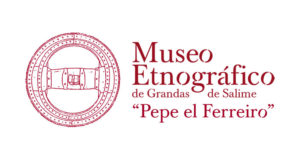Bee-keeping was a basic activity in the councils of western Asturias. Honey was consumed as food, especially in summer, and also as a medicine. It was also an appreciated gift offered as a token of good neighbourliness and in gratitude for favours. The wax was sold to the cereiros from Ancares (León) who travelled the territory buying it from the houses.
The hives or trobos were made from a hollow trunk, four boards or cork, and were placed in the vicinity of the houses and in the cortinos, circular constructions with a masonry fence to defend the hives from bears, an example of which can be seen in the Museum itself (14). In addition to the hives, beekeeping involves a variety of tools and implements: trobos made from the bark of escornella (Sorbus aucuparia) to collect swarms, esmelgadoras to esmelgar or cut the honeycombs in the hive, trobos del mel or hollow trunks with a base and lid in which the honey is kept, presses to squeeze and clean the wax, etc. To make the candles, bivalve moulds and wooden containers were used in which the wicks were dipped in the liquid wax.

